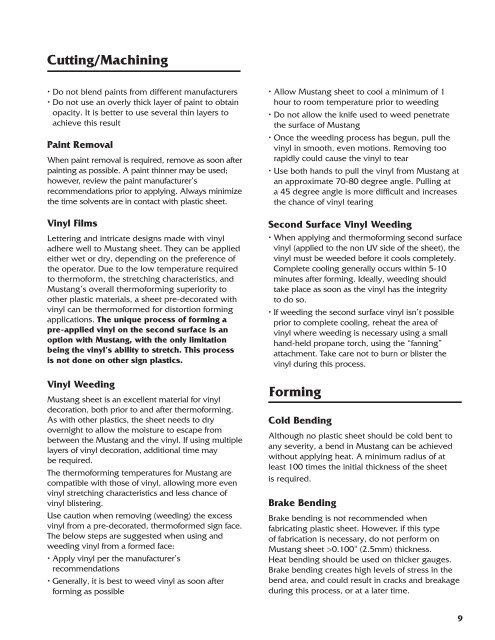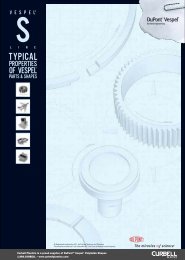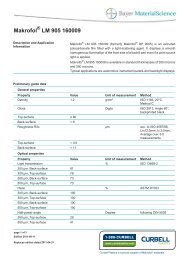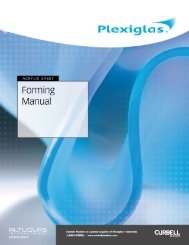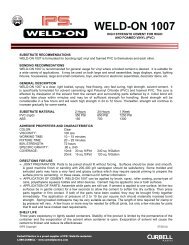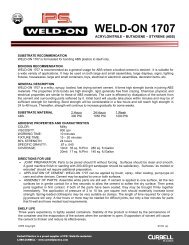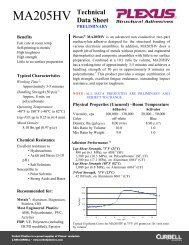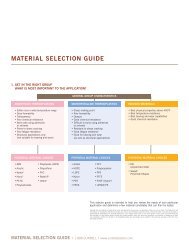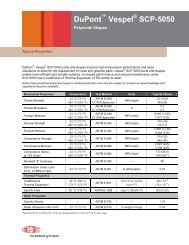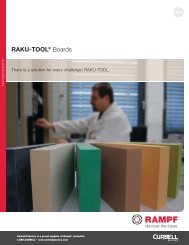Mustang Sheet Fabrication Guide - Curbellplastics.com
Mustang Sheet Fabrication Guide - Curbellplastics.com
Mustang Sheet Fabrication Guide - Curbellplastics.com
- No tags were found...
You also want an ePaper? Increase the reach of your titles
YUMPU automatically turns print PDFs into web optimized ePapers that Google loves.
Cutting/Machining• Do not blend paints from different manufacturers• Do not use an overly thick layer of paint to obtainopacity. It is better to use several thin layers toachieve this resultPaint RemovalWhen paint removal is required, remove as soon afterpainting as possible. A paint thinner may be used;however, review the paint manufacturer’sre<strong>com</strong>mendations prior to applying. Always minimizethe time solvents are in contact with plastic sheet.Vinyl FilmsLettering and intricate designs made with vinyladhere well to <strong>Mustang</strong> sheet. They can be appliedeither wet or dry, depending on the preference ofthe operator. Due to the low temperature requiredto thermoform, the stretching characteristics, and<strong>Mustang</strong>’s overall thermoforming superiority toother plastic materials, a sheet pre-decorated withvinyl can be thermoformed for distortion formingapplications. The unique process of forming apre-applied vinyl on the second surface is anoption with <strong>Mustang</strong>, with the only limitationbeing the vinyl’s ability to stretch. This processis not done on other sign plastics.Vinyl Weeding<strong>Mustang</strong> sheet is an excellent material for vinyldecoration, both prior to and after thermoforming.As with other plastics, the sheet needs to dryovernight to allow the moisture to escape frombetween the <strong>Mustang</strong> and the vinyl. If using multiplelayers of vinyl decoration, additional time maybe required.The thermoforming temperatures for <strong>Mustang</strong> are<strong>com</strong>patible with those of vinyl, allowing more evenvinyl stretching characteristics and less chance ofvinyl blistering.Use caution when removing (weeding) the excessvinyl from a pre-decorated, thermoformed sign face.The below steps are suggested when using andweeding vinyl from a formed face:• Apply vinyl per the manufacturer’sre<strong>com</strong>mendations• Generally, it is best to weed vinyl as soon afterforming as possible• Allow <strong>Mustang</strong> sheet to cool a minimum of 1hour to room temperature prior to weeding• Do not allow the knife used to weed penetratethe surface of <strong>Mustang</strong>• Once the weeding process has begun, pull thevinyl in smooth, even motions. Removing toorapidly could cause the vinyl to tear• Use both hands to pull the vinyl from <strong>Mustang</strong> atan approximate 70-80 degree angle. Pulling ata 45 degree angle is more difficult and increasesthe chance of vinyl tearingSecond Surface Vinyl Weeding• When applying and thermoforming second surfacevinyl (applied to the non UV side of the sheet), thevinyl must be weeded before it cools <strong>com</strong>pletely.Complete cooling generally occurs within 5-10minutes after forming. Ideally, weeding shouldtake place as soon as the vinyl has the integrityto do so.• If weeding the second surface vinyl isn’t possibleprior to <strong>com</strong>plete cooling, reheat the area ofvinyl where weeding is necessary using a smallhand-held propane torch, using the “fanning”attachment. Take care not to burn or blister thevinyl during this process.FormingCold BendingAlthough no plastic sheet should be cold bent toany severity, a bend in <strong>Mustang</strong> can be achievedwithout applying heat. A minimum radius of atleast 100 times the initial thickness of the sheetis required.Brake BendingBrake bending is not re<strong>com</strong>mended whenfabricating plastic sheet. However, if this typeof fabrication is necessary, do not perform on<strong>Mustang</strong> sheet >0.100" (2.5mm) thickness.Heat bending should be used on thicker gauges.Brake bending creates high levels of stress in thebend area, and could result in cracks and breakageduring this process, or at a later time.9


